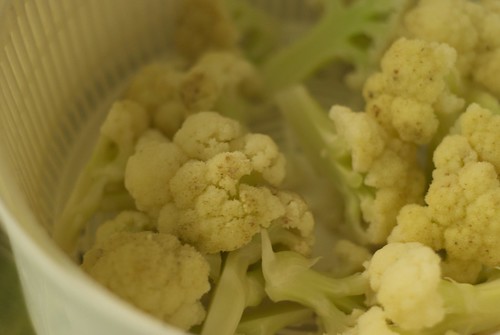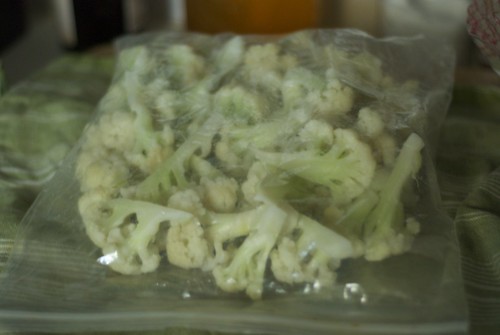
I love the height of summer produce season when my kitchen is filled with vegetables and fruit, sometimes piled on tables, sometimes tucked into the fridge. As I peruse recipes and decide how to use my treasure I am inspired by such great potential.
Each week, after a day at the farm, I bring home a big bag of produce: summer squash, beans, corn, cauliflower, tomatoes, basil, eggplant. There is plenty for us to eat all week and usually some extra. Before it wilts or turns to mush, I often freeze what I know we won't eat within the week. Freezing produce isn't as dreamy and picturesque as canning which leaves you with beautiful jars to admire. On the other hand, it doesn't take as much time or as much steam in the kitchen and blanching and freezing probably preserves more of the nutrients than canning does. I don't have tons of freezer space but there is enough room to store plenty of frozen produce.
This year I have been trying to be more careful and diligent about my freezing, so I thought I would share my process in case you want to start freezing vegetables. The most important thing to remember is that if you don't want to eat it now and you don't think you will eat it later (in the middle of winter) then don't bother freezing it. My favorite things to freeze are corn, snap pea pods, slow roasted tomatoes, roasted peppers and green beans. I also like frozen broccoli and cauliflower, though I would rather eat them fresh.

The basic process is: prep the vegetables by removing stems or inedible parts and cutting them into evenly sized pieces. You don't have to cut up everything: beans would be fine whole, with their stems removed but broccoli should be cut into florets. I cut my beans in half or thirds because I know that I would rather use them that way. Once they are frozen it is hard to cut them up and it is nice that they are ready to use when you pull them out of the freezer.
While I am preparing the vegetables, I start boiling the water. I tend to freeze in small batches as I have the vegetables so I use a wide 7 quart pot, about one third full of water. I have another pot that has a small strainer basket which I put in the 7 quart pot so I can quickly remove the vegetables when they are blanched. I have been trying to use one pot of water for a couple of kind of vegetables so, for example, I put the cauliflower in first and once it comes out, I put the beans in. For blanching times I refer to this site.

While the first batch of vegetables is in the pot, I fill a bowl with cold water and maybe a few ice cubes. When the blanching time is up, I dump the blanched cauliflower (or whatever vegetable it is) into the cold water bath. Then I put the next batch in the strainer basket and blanch it. Once the beans have blanched, the cauliflower should be cool. I scoop the veggies out of the cool water bath and put them in the basket of my salad spinner. Then I dump the just blanched veggies into the cold water (adding more cold if needed). I spin the veggies as dry as I can and then spread them on a clean dish towel to soak up the rest of the water. I store most of my veggies in large ziplock bags but if I only have half a bag full then I add more to it the next time I have more veggies to freeze.
Tomatoes and peppers get roasted in the oven and put into freezer bags when they are cool. Last week I put some ears of corn in the oven to roast alongside the peppers then cut it off the cob but if I am blanching vegetables then I put ears of corn in the boiling water when the other vegetables are done.
Most fruits can be frozen without blanching, just remove stems or pits and dice larger fruits into smaller pieces.
As I enjoy all the good fresh produce of summer I am happy to know that I will have plenty tucked away for winter, too.

No comments:
Post a Comment